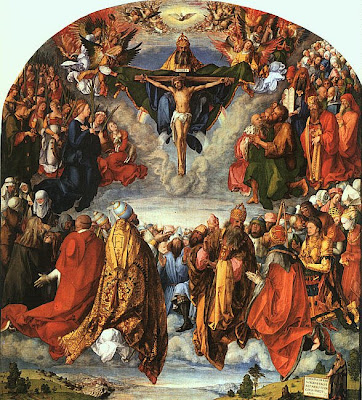This afternoon Fr Jerome Bertram C.O., as Prefect of Brothers at the
Oxford Oratory, took a small group of us on an excursion to Mapledurham House on the banks of the Thames. Situated down a winding lane off the Qxford to Reading road it is famous as a recusant house. There is quite a sense of discovery and of going back in time as one approaches the village, house and church.
The
estate was bought in 1491 by the Blount family who began building the
present house in 1588. The house, with many alterations and changes but
still recognisably Elizabethan, has remained in the possession of the Blounts and their heirs the Eyston family ever since.
As
a recusant centre the house has priestholes created by St Nicholas
Owen, and was the scene of the unsuccessful courtship by Alexander Pope
of a member of the family. More recently it has been considered to be
one of the possible inspirations for Toad Hall in
The Wind in the Willows and the house and village was used for the 1976 film
The Eagle Has Landed.
The estate website can be viewed
here, and I would certainly recommend any one interested to visit Mapledurham.
Our first visit was to the Mill. This is the last working watermill on the Thames. A mill is recorded at Mapledurham
in Domesday Book in 1086 - presumably on the same site. The core of the
presnt building is fifteenth century, and has seventeenth century
extensions.
At one side the water turns a modern electricity turbine,
but inside one can see how the mill works, and appreciate the
elaboration of traditional rural technology. As a result I think I now appreciate rather better how this vital part of the rural economy worked. There are informative
displays and a guide book to assist, as well as flour and other related products
from the mill on sale.
.

Mapledurham Mill
Image: panoramio.com
The
house has some handsome interiors, which suggest a quiet prosperity in
the past, but that as recusants the Blounts had not had the money to
spend which other families did who did not face fines and double land
tax. The chapel is a very attractive Gothick addition of the eighteenth
century. There is an interesting array of family portraits from the
sixteenth century, and masses of more recent family photographs.

Mapledurham House from the east
Image: panoramio.com
On
the front lawn there was a quintessentially English Jubilee fete going
on. We joined in singing the National Anthem, drank the Queen's health
and signed the loyal address to Her Majesty, as well as meeting the
owner of the estate, Mr John Eyston, before having a good afternoon tea
in the stable yard.
From there we went on to look at the parish
church of St Margaret. A medieval building, but with a substantial part
dating from Butterfield's mid-nineteenth century restoration, it has the intersting feature of
the Blount aisle, which is still the private possession of family, and
hence Catholic, although without an altar due to the crowding in over
the centuries of tombs. The aisle and earliest tombs are the work of the
Bardolf family from the 1390s, predecessors of the Blounts.
In
1828 the Vicar, Charles Sumner, resigned the living and went on,
eventually, to become Archbishop of Canterbury. His successor, initially
reluctant, was the Rt. Hon. and
Rev. Lord Augustus FitzClarence - one of the illegitimate sons of the
future King William IV and Mrs Jordan. Born in 1805 he was to serve as
Vicar from 1828 until his death in 1854 - and proved a conscientious
incumbent, although he failed to secure possession in a court case of
the Blount aisle.
This was athoroughly enjoyable afternoon - time spent with friends, a
charming and historic place to visit, the mental stimulus of learning
about a place and its past, and, on this Jubilee weekend, a very real
sense of enduring Englishness.



